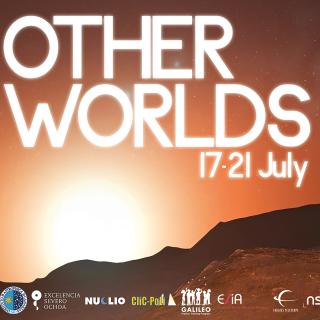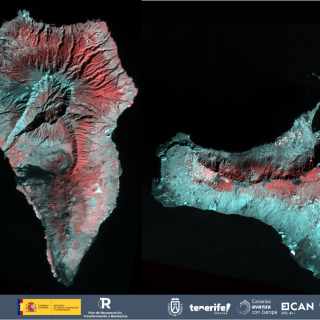ANIMATIONS AVAILABLE AT BETACAM: Tel.: 922 605206 and 922 605371
(SUMMARY AND SCRIPT TO ACCOMPANY ANIMATIONS)
Black holes aren´t science fiction any more. Even though they can´t see them directly, astronomers know of their existence owing to their influence on the stars that orbit around them. But what astronomers didn´t know with certainty until now was how these black holes were formed or whether they really marked the final destiny of many stars.
Researchers at the Instituto de Astrofísica de Canarias (IAC), in collaboration with a group from the University of California, using the 10 metre Keck Telescope, have detected the remains of a violent thermonuclear explosion in a star that now orbits a black hole in our Galaxy.
The companion star, witness to the explosion, has become enriched, say the astronomers, with large amounts of oxygen, magnesium, silicon and sulphur.
These chemical elements are produced only in supermassive stars, which alone are capable of contaminating their surroundings with them through stellar explosion in the form of supernovae or hypernovae.
These results demonstrate for the first time that a star with a mass 30 times that of the Sun gave rise during one such event to a black hole that has now taken its place.
Investigative team:
Rafael Rebolo, project leader and CSIC lecturer, IAC
Garik Israelian, IAC post-doctoral researcher
Jorge Casares, IAC post-doctoral researcher
Eduardo Martín, post-doctoral researcher at the University of California, formerly an IAC researcher
Gibor Basri, professor at the University of California
(FURTHER INFORMATION)
Supermassive stars, with masses about 30 times that of the Sun, end their lives in either a supernova or hypernova explosion, or in a state of gravitational collapse. Theoretically, both processes lead to the possible formation of a black hole, but until now neither of these scenarios has been confirmed observationally. In an article ("Evidence of a Supernova Origin for the Black Hole in GRO J1655-40") published in today's Nature, astronomers from the IAC and the University of California, Berkeley, present the results of a study on the chemical composition of the star orbiting the black hole in the system GRO J1655-40 (Nova Scorpii 1994). This star reveals a high atmospheric content – ten times greater than in the Sun - of oxygen, magnesium, silicon and sulphur. These chemical elements were created in nuclear reactions of the type that take place inside very massive stars when they reach temperatures of thousands of millions of degrees and are ejected into the surrounding medium if the star ends its life in a supernova explosion. During this process, apart from the enrichment of the surrounding medium with new chemical products, the formation of a neutron star or a black hole is thought to occur.
Until now, there has been abundant evidence for the formation of neutron stars following supernova explosions, but there has been no evidence for the formation of black holes. 'Our work has shown,' says Rafael Rebolo, a CSIC lecturer at the IAC, 'that one of the best examples of a black hole in our Galaxy, with a mass determined dynamically of between four and eight times that of the Sun, was created in an extremely violent explosion of a very massive star, whose remains have now been detected.'
The composition of the ejected matter could determined due to the existence of a neighbouring star that survived the explosion, although it was significantly contaminated by the ejecta. 'This star,' according to Garik Israelian, another member of the research group and astronomer at the IAC, 'bore witness to the phenomenon and fortunately remained gravitationally bound to the black hole at a distance today of about 17 million kilometres, thereby not only allowing a highly precise determination of the dynamical properties that support the hypothesis of the existence of a black hole in the system, but also enabling us to unveil its possible origin.'
Supernovae and hypernovae
The relative proportions of oxygen, magnesium, silicon and sulphur that have been observed tally very well indeed with recent predictions for the production of elements in hypernovae, a new, much more violent class of supernovae, whose existence was proposed last year in order to explain the detection of a highly energetic supernova associated with a gamma-ray burst. More recent investigations into massive rotating stars that collapse favour the hypothesis that such stars, after exploding as hypernovae, give rise to the formation of black holes with masses similar to that which seems to exist in the GRO J1655-40 system.
Professor Ken Nomoto, of the University of Tokyo, believes that there is a high probability that we are dealing with a hypernova, since, if it were an ordinary supernova, most of the iron, sulphur and silicon synthesized in the explosion would have fallen back towards the massive black hole without reaching the surrounding medium. 'Only a hyper-energetic explosion,' he says, 'in other words, that due to a hypernova, could explain the observed ejection of sulphur and silicon.'
Jorge Casares, the discoverer in 1992 of the black hole in system V404 Cygni, considers that this work, extended to other binary systems containing black holes and neutron stars, will lead to the clarification of the connection between these systems and the final evolutionary stages of the precursor stars, and to a better knowledge of the production of elements in the violent explosive events attending the birth of black holes.


